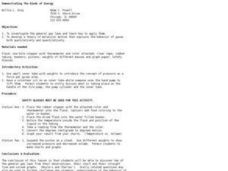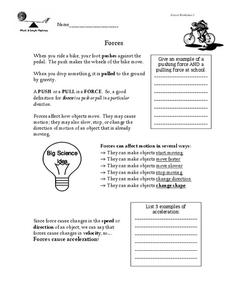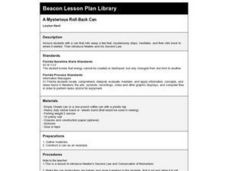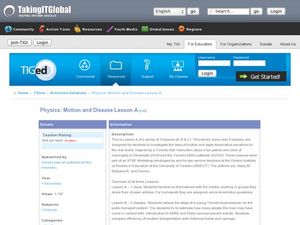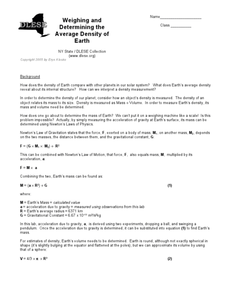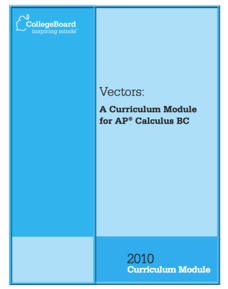Curated OER
Demonstrating the Kinds of Energy
Students experiment with inner tubes, weights, flasks, and pistons to demonstrate the gas laws. In this molecular motion lesson, students demonstrate pressure as a force per area. They conduct an experiment to show the relationship...
Curated OER
Movement of Objects
Ninth graders investigate motion. In this science lesson, 9th graders conduct experiments on objects to analyze motion and speed. They define motion in everyday life.
Curated OER
Opposites Attract
Pupils demonstrate the attraction of small pieces of paper to a charged plastic rod and conduct experiment with other objects to determine whether they can hold a charge. They then use online applets to apply their experiments to...
Curated OER
TE Activity: Wow! That Captures It!
Students examine how motion capture technology allows computer based animators to design realistic effects in animation. They study how the center of gravity contributes to animation and how to use the center of gravity to write an...
Curated OER
Forces
In this forces worksheet, students read about force and acceleration. They complete a Venn Diagram to compare and contrast balanced and unbalanced forces, they answer questions about a diagram of a tug-a-war and the forces acting on each...
Curated OER
Motion
In this motion worksheet, students will read 8 statements about displacement and velocity and determine if the statement is true or false. Then students will fill in the blank for 8 statements on motion. Finally, students will compare...
Curated OER
Orbital Motion
Students use a formula to measure the eccentricity of an ellipse, then state Kepler's Law of Elliptical Orbits. They predict the solar energy received at different positions in a planet's orbit.
Curated OER
America's Pastime
Young scholars relate Newton's Laws of Motion to the game of baseball. They compare and contrast the materials used in baseballs that could affect their performance. They also determine how friction can be increased or decreased in a...
Curated OER
A Mysterious Roll-Back Can
Middle schoolers explore Newton and his Second Law by observing a demonstration involving a can that rolls away, then rolls back to where it started. They construct their own Come Back Can and describe how the cans work.
Curated OER
Physics: Motion and Disease
Students read media and identify examples of science technology and society. For this physics lesson, students learn about acceleration and velocity. Students estimate how many people would have come in contact with a person who...
Curated OER
Design Your Own Rube Goldberg Machine
Students participate in a culminating activity for a unit on Energy and Simple Machines. They are challenged to incorporate simple machines in to a complex mechanical system. While designing and testing their machine they will also...
Curated OER
What is the Attraction?
Second graders investigate the law of polarity. In this magnets instructional activity, 2nd graders discover how magnets are used in everyday life and which objects in our environment are magnetic. Students experiment with bar magnets...
Curated OER
Earth Turns? Prove It!
Students construct a pendulum using a washer and thin fishing line. In this earth science activity, students simulate Earth's rotation using the pendulum bob and swivel chair. They explain how this activity proves that the Earth is...
Curated OER
Challenger's Lost Lessons - The Lost Simple Machines Lesson
Students investigate the characteristics of simple machines. In this simple machine lesson, students investigate work as a product of applying constant force. They answer questions about what happens on Earth and what may have happened...
Curated OER
Bobsled Challange
Students investigate the effects of materials on the friction between a "bobsled" and the track. They explore the effects of weight on the motion of the bobsled. Students design a bobsled for either fast or slow movement. They discuss...
Curated OER
May the Force Be With You
Students work in groups, they investigate how different forces act upon objects and how this information can be used in their day-to-day lives. They wrap the rubber band around the book. Students place the bo.ok and ruler on top of a...
Curated OER
Design a Parachute
Students engage in a discussion about what a parachute is and how it works. They create a parachute using different materials that they think will work best. The students test their designs, which will be followed by a class discussion...
Curated OER
Inertia
Students become actively involved with Newton's First Law of Motion, which involves inertia.
Curated OER
Weighing and Determining the Average Density of the Earth
Some background information about density and Newton's Laws of gravitation and motion assist pupils in the following experiment. The procedure will help them further their understanding of gravity, pendulums, and a drop-ball experiment....
Curated OER
Kites: Patang - The Indian Fighter Kite
Students investigate the history of fighter kites and build their own. In this aeronautics lesson, students discover how other countries utilize fighter kites and where they originated. Students create their own fighter kites in class...
Curated OER
Help Wanted: A Lighting Engineer For Popular Rock Group
Students are assigned to groups, and determine each member's role in the group. They will design an experiment to determine a way to produce the three primary and five secondary colors. Students discuss color and mood. They listen to a...
Physics Classroom
From a Feather to an Elephant
It is always a rush to drop objects from great heights, and with this physics experiment, class members will not be disappointed! They drop a single coffee filter from a balcony or table top, record the time it takes to reach the ground,...
Noyce Foundation
Truffles
Knowing how to scale a recipe is an important skill. Young mathematicians determine the amount of ingredients they need to make a certain number of truffles when given a recipe. They determine a relationship between ingredients given a...
College Board
Vectors: A Curriculum Module for AP® Calculus BC
It is all in a matter of time. The model curriculum module uses parametric equations and vectors to solve problems dealing with particle motion along a curve. At the beginning of the lesson, the unit reviews parametric equations and...


